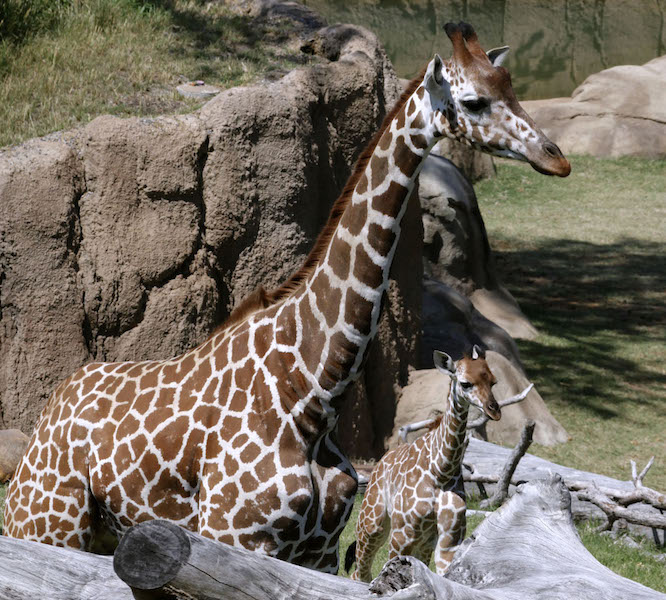Giraffe to Give Birth at Dallas Zoo: Watch It Live Online

If you've ever wanted to see a giraffe being born, now's your chance.
Katie, a giraffe at the Dallas Zoo, is due to give birth any day now, and Animal Planet installed 10 cameras in the zoo's maternity barn to give at-home viewers a chance to witness the remarkable event and learn about the state of these animals in the wild.
The cameras are rolling 24/7, ready to capture the birth from all angles. You can watch it live on Live Science or on the Animal Planet TV channel. [World's Cutest Baby Wild Animals]
Katie's window for delivery extends until mid-May, but the birth will likely happen within the next week or two, said Laurie Holloway, a spokeswoman for the Dallas Zoo.
"We hope we get some signs a day or two before she actually goes into labor," Holloway told Live Science. However, "It's quite possible the first notice we'll get that she's in labor is when her water breaks," she added.
How giraffes are born
The average gestation period for giraffes is 15 months. Baby giraffes, known as calves, typically weigh 100 to 150 lbs. (45 to 68 kilograms) and are about 6 feet (1.8 meters) tall when they're born, according to Animal Planet.
Sign up for the Live Science daily newsletter now
Get the world’s most fascinating discoveries delivered straight to your inbox.
Giraffes give birth standing up, and the baby falls — head and hooves first — from a height of 6 feet, Holloway said. This dramatic entrance breaks the amniotic sac, a fluid-filled pouch that protects the fetus in the womb, severs the umbilical cord, and forces the calf to start breathing on its own. After the calf is born, its mother will clean it. Within 20 to 45 minutes after its birth, the calf will begin to stand, and within an hour, it will start nursing, Holloway said.
The calf will nurse for between 9 and 12 months, but will begin to eat solid food (leaves) within four months. Male giraffes will leave their mothers after 15 months to form a group with other males, and females will leave their moms after 18 months but will continue to live as part of the group of giraffes (known as a "tower"), according to Animal Planet. [In Photos: See Cute Pics of Baby Giraffes]
To prepare for a birth, zookeepers and veterinarians work with giraffes to get them used to technology that can help make the delivery safer and smoother, whether in a normal birth or during an emergency. A giraffe restraint device keeps the animal from moving during ultrasounds, routine checkups and delivery, if veterinary intervention is needed. Katie's zookeepers have trained her to be comfortable walking into such a device.
Katie will give birth in a specially prepared maternity stall that has been outfitted with 6 inches (15 centimeters) of soft dirt to cushion the baby's fall, Holloway said. Zookeepers will have first aid and milk available for the calf if it needs it.
The sex of the baby giraffe is not yet known. "We won't know until it pops out and we can get a good look," Holloway said.
The baby's father is a giraffe named Tebogo, and zookeepers said he fathered another calf born in October named Kopano. The zoo auctioned off the right to name that calf for $50,000, with proceeds going to giraffe conservation efforts in Africa, Holloway said.
Giraffes in the wild
In the wild, giraffes give birth in places known as calving grounds, and will return to these grounds year after year to give birth. Sometimes, these are the same sites where the mother giraffe was born, according to Animal Planet.
Giraffes are the world's tallest mammals. Their height varies among the nine different subspecies, but some can be up to 20 feet (6.1 m) tall. Reticulated giraffes (or Somali giraffes) are, on average, 14 to 19 feet (4.3 to 5.8 m) tall, according to Animal Planet.
Although giraffes are not endangered and are listed as "least concern" by the International Union for Conservation of Nature (IUCN)'s Red List of Threatened Species, their population is decreasing. About 80,000 wild giraffes live on the African continent — more than 40 percent fewer than in 1999, when there were 140,000 animals, according to the IUCN. The reticulated giraffe has an estimated population of 4,700 — down from the estimated 31,000 in 1998, according to the Giraffe Conservation Foundation.
Follow Tanya Lewis on Twitter. Follow us @livescience, Facebook & Google+. Original article on Live Science.










